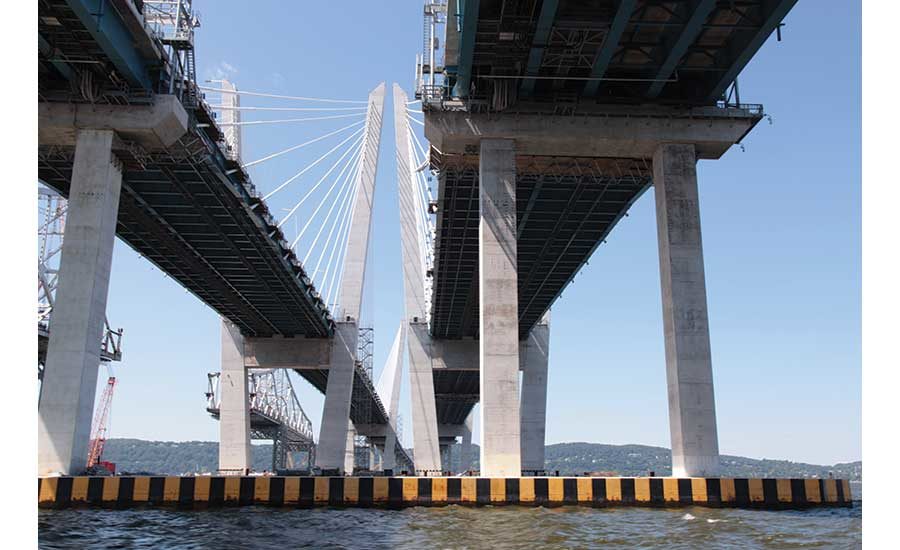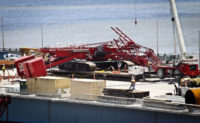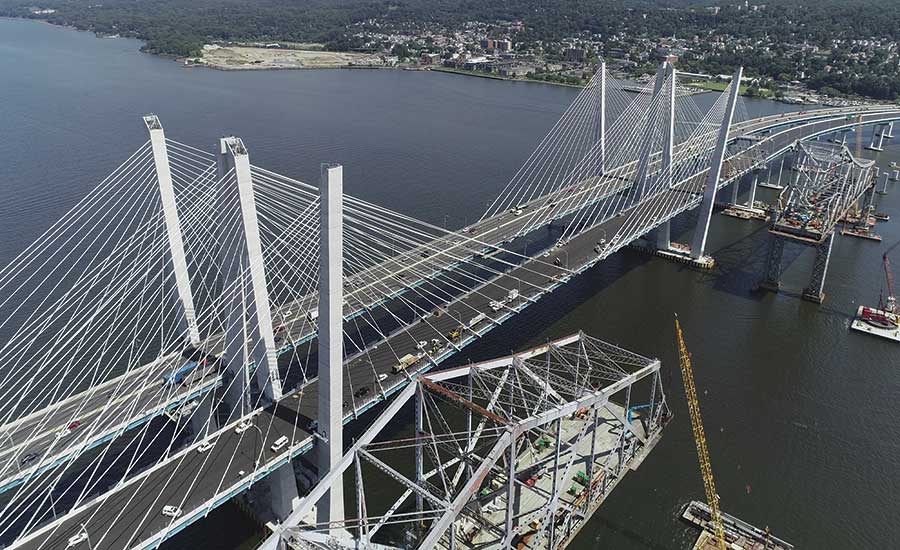New York's Old Tappan Zee Bridge Won’t Go Out Quietly
The Thruway Authority responds to a New York Times story about the second span debut

The twin structures of the Mario Cuomo Bridge during construction.
PHOTO COURTESY OF FLUOR

The Tappan Zee Bridge, a source of controversy and drama even before construction began on its $3.9-billion, 3.1-mile-long twin-span cable-stayed replacement, is going out with more of the same. The contractor delayed the scheduled Sept. 9 opening of the southern span of the Mario M. Cuomo Bridge after workers heard a suspicious noise. The popping sound originated from the old bridge’s east anchor span, prompting engineers to order an inspection of the old bridge’s joints.
PHOTO BY VICTOR OBIDIMALOR FOR ENR


The Tappan Zee Bridge, a source of controversy and drama even before construction began on its $3.9-billion, 3.1-mile-long twin-span cable-stayed replacement, is going out with more of the same. The contractor delayed the scheduled Sept. 9 opening of the southern span of the Mario M. Cuomo Bridge to the night of Sept. 11 and morning of Sept. 12 after workers heard a suspicious noise. The popping sound originated from the old bridge’s east anchor span, prompting engineers to order an inspection of the old bridge’s joints.
In a Sept. 8 statement, Terry Towle, president and project executive of Tappan Zee Constructors, said, “A deviation in one of the old bridge’s joints was observed. The flawed joint could possibly cause a part of the old structure to fail and fall. Due to the proximity of the old structure to the new span, we erred on the side of caution and chose to delay the traffic switch.”
The next day, the Fluor-led design-build team stated: “After careful evaluation, Tappan Zee Constructors has determined that the old Tappan Zee Bridge east anchor span is damaged but currently stable with certain key components highly stressed. … While there remains a possibility of the old bridge east span failing, in the event it does, it will fall within a safety zone that does not affect vessel traffic or the structural integrity of the new eastbound bridge.”
On Sept. 7, Gov. Andrew Cuomo (D) led a lavish ceremony announcing the planned opening of the second span. On Sept. 11, The New York Times ran an article based on a letter sent by New York State Thruway Authority project executive Jamey Barbas to Towle offering to absorb extra costs and traffic responsibilities if the team would open the second span in August. Gov. Cuomo faced democratic opponent Cynthia Nixon on Sept. 13 in the New York State primary.
“We strive to manage the project through collaboration with the goal of opening the bridge timely to the benefit of the traveling public.”
– Jamey Barbas, project executive New York State Thruway Authority
Barbas released a statement Sept. 12: “The contract completion date of August 15 was extended ten days to August 25 due to severe weather delays. The letter does not suggest incentives, or absolve TZC of liability for traffic incidents or overall safety – rather, we were attempting to assist TZC in meeting its contractual deadline by allowing them to finish ancillary and nonessential work while the lanes were open to traffic. Such ancillary work included painting of downspouts below the roadway and the Authority offered to assist with off peak lane closures on a wide bridge with shoulders. That work would never have compromised safety and TZC was always to remain liable. At the end of the day the suggestions to help the contractor were unnecessary and no costs were expended by the Authority as the span was completed in full on September 7 as proposed by the contractor.”
Barbas added: “This letter was sent in my capacity as project director to keep the project on schedule as permitted by contract, and I did so without advising or in consultation with anyone in the governor’s office.”
Tappan Zee Constructors stated from the beginning that it expected to complete the first span by the end of last year, which it did, and to substantially complete the bridge by the end of this year.
Speaking to ENR in August, Barbas said the authority realized the August opening would have to be pushed back due to high humidity and heavy rain that affected the three layers of waterproofing being placed on the new deck.
Crews had already removed major portions of the old bridge, with a 603-ft piece, the largest, slated to be removed with strand jacks and barges.
Barbas noted in August that the demolition was her biggest safety concern, particularly removing concrete caissons as deep as 60 ft. “Crews will have to ‘collapse’ the caissons and get all the debris out. It will be the most challenging part of the job safety-wise,” she said.
The demolition includes 302,200 tons of concrete, 46,790 tons of steel, 13,192 timber foundation piles, 2,000 precast deck panels, 196 piers, 30 circular caissons, 20 steel truss sections and eight rectangular caissons.
Tappan Zee Constructors will continue construction on the thruway authority maintenance and state police facilities in Tarrytown, a bike and pedestrian path and scenic overlooks, and a Westchester-side welcome center. Barbas adds that concepts for six scenic lookouts and the welcome center are still in progress.
Trials and Triumphs
The project experienced a series of difficulties, starting early on when one of the four teams decided at the last moment not to submit a bid (ENR 8/13/12, p. 20). In July 2013, two people were killed when their motorboat collided with a barge near the bridge. In 2013 and 2014, several work barges came unmoored.
A barge-mounted concrete batch plant partially collapsed in December 2014. The joint venture filed a lawsuit against the supplier. In July 2016, the boom of a mobile crane crashed onto the decks of the new and existing bridges. OSHA fined the team in 2017.
But the project has also had its share of victories. With just a few feet to spare, the crane called the Left Coast Lifter, and renamed I Lift NY, successfully squeezed under the old Tappan Zee Bridge in October 2014. It is one of the world’s largest cranes, with 328-ft-long twin booms and a lifting capacity of 1,750 metric tons.
The cable-stayed main span is supported by eight 419-ft towers, which angle out five degrees and feature a sleek, chamfered design. The towers support 192 stay cables, which are made up of roughly 4,900 miles of steel strands. Redundancy in the truss, galvanized rebar and chloride-resistant concrete are among the elements giving the new bridge its 100-year design life expectancy.
The old bridge, which caused the delay and will continue to challenge crews with its removal, is also leaving behind a positive legacy. This summer, 135 concrete deck panel units from the old Tappan Zee Bridge were shipped to local municipalities across New York. Installed within the last 10 years as part of ongoing maintenance of the existing bridge before reconstruction finally began, the 13-ft wide, 50-ft-long panels have been sent to 13 municipal maintenance yards for immediate and future infrastructure needs.
Moreover, recycled materials from the old bridge are now bolstering 12 artificial reefs off the shores of Long Island—the largest expansion of artificial reefs in state history, according to the governor’s office.
To mitigate relocation of oyster habitats caused by the bridge construction, the authority partnered with local groups to place 422 steel gabion cages and concrete reef balls on the Hudson’s riverbed to promote oyster reef habitats at three sites near the new bridge.
By Aileen Cho in Tarrytown, N.Y.




